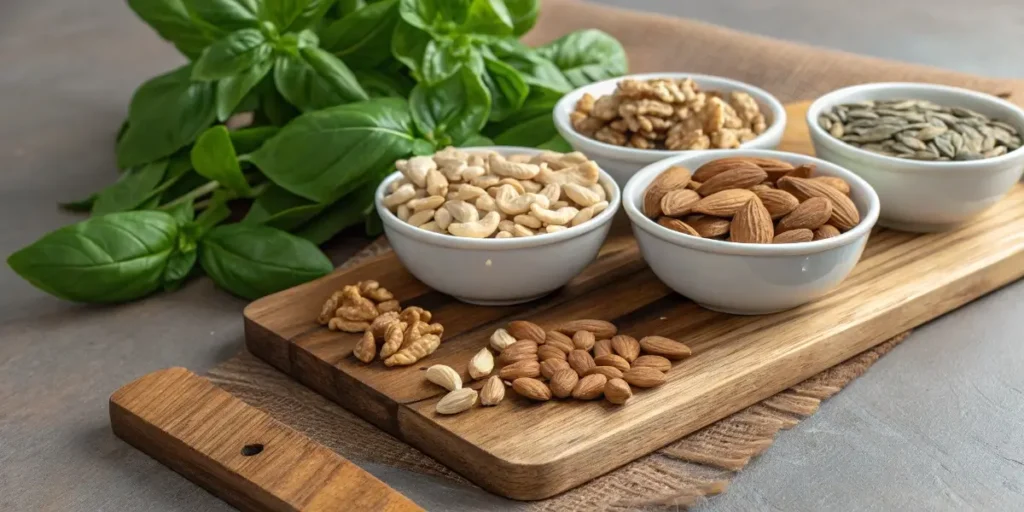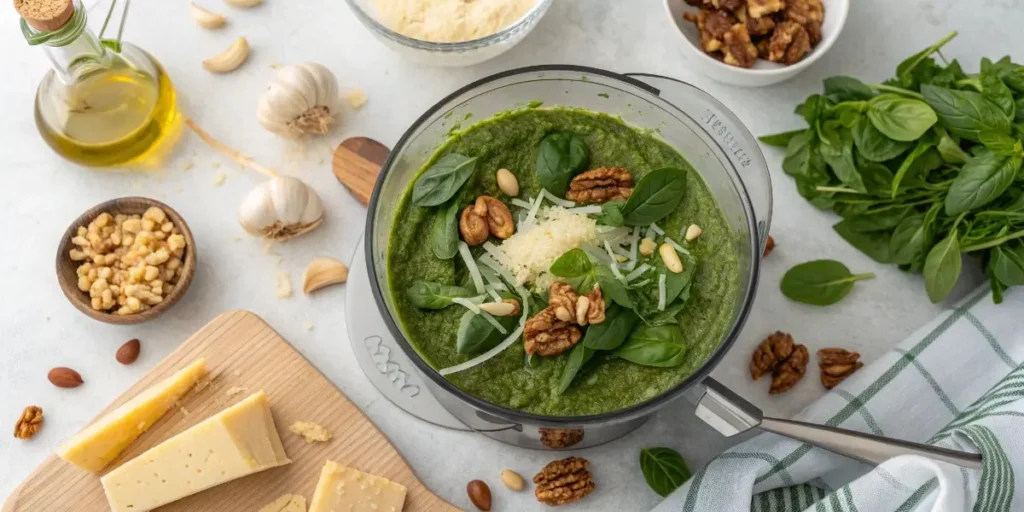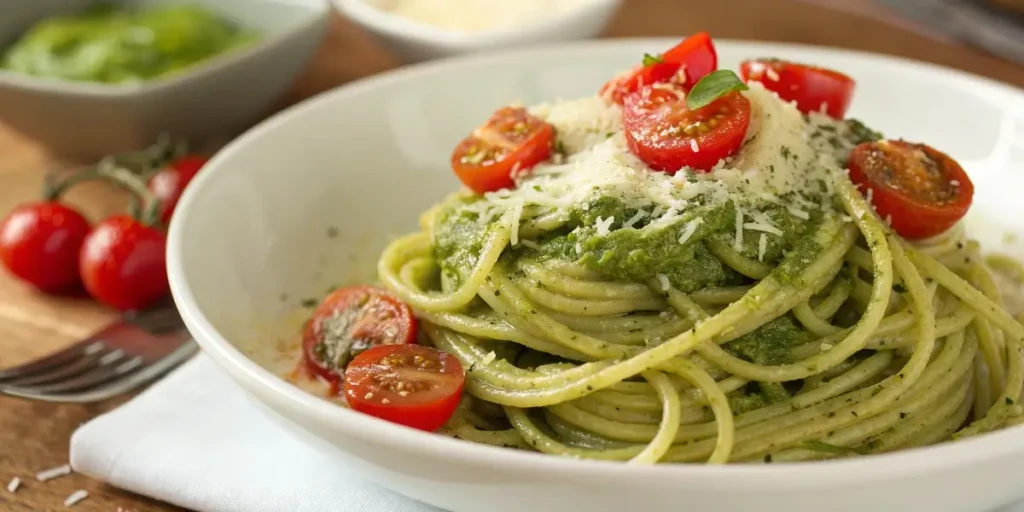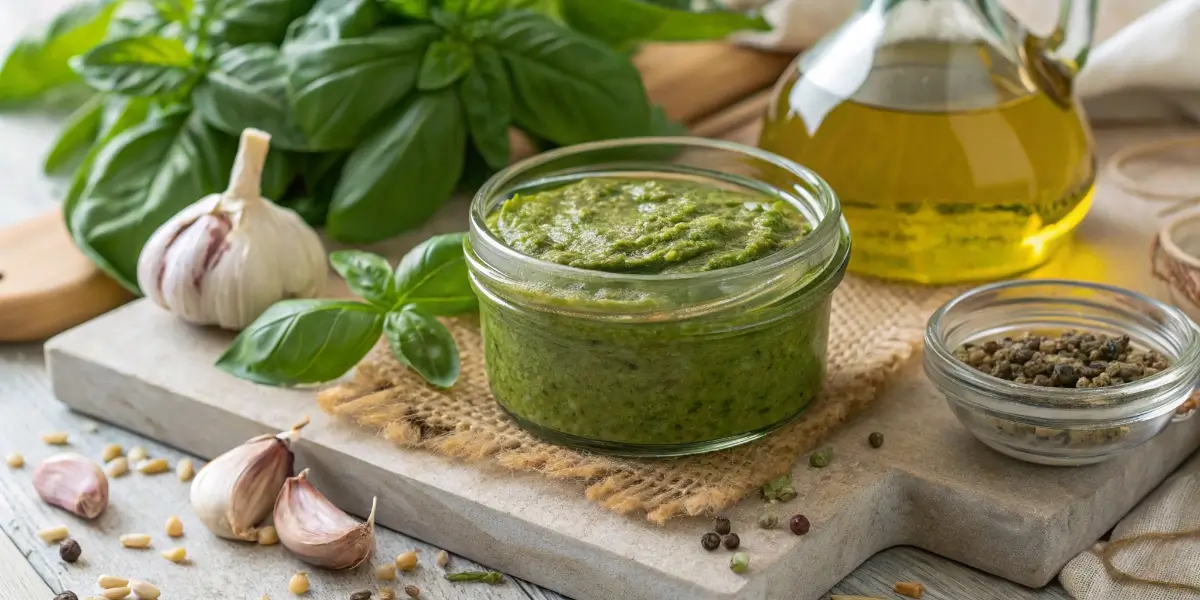Pesto Recipe Without Pine Nuts – Easy, Flavorful, and Budget-Friendly Alternative
Making pesto at home doesn’t have to cost a fortune or cause nut-related worries. This pesto recipe without pine nuts delivers all the bright, aromatic flavor of traditional basil pesto using simple, affordable, and allergy-friendly ingredients. Whether you’re avoiding pine nuts due to allergies, cost, or availability, you’ll learn how to make delicious, creamy pesto in minutes. In this guide, we’ll explore substitutes for pine nuts, nut-free versions, and even creative variations to suit every taste.
Check out our delicious ground beef crock pot recipes for hearty meal inspiration, or learn more about easy fish food recipes to try at home to pair with your pesto pasta.
Table of Contents
What Is a Pesto Recipe Without Pine Nuts?
Understanding Traditional Pesto and Its Core Ingredients
Traditional Italian pesto, known as Pesto alla Genovese, combines fresh basil, pine nuts, garlic, Parmesan cheese, and olive oil. The result is a rich green sauce bursting with herbal aroma and nutty undertones. But pine nuts can be expensive or hard to find, making many home cooks search for an easy pesto recipe without pine nuts that still captures the same bold flavor.
In pine nut-free pesto, the core balance remains the same—fresh herbs, fat (olive oil), and umami (cheese or nutritional yeast). The secret is choosing the right substitute for pine nuts to maintain creaminess and depth. Options like walnuts, almonds, or sunflower seeds mimic the texture beautifully while bringing their unique taste to the mix.
How Pine Nut-Free Pesto Differs in Texture and Flavor
Without pine nuts, your pesto can actually have a smoother, creamier consistency depending on the substitute used. For instance, cashews add a subtle sweetness, while sunflower seeds provide earthiness. Texture-wise, nut-free pesto is slightly less oily but still lush and rich when balanced correctly.
Here’s a quick comparison of texture and flavor:
| Ingredient | Flavor Profile | Texture | Best For |
|---|---|---|---|
| Walnuts | Earthy, slightly bitter | Coarse | Pasta, sandwiches |
| Cashews | Mild, creamy | Smooth | Dressings, dips |
| Sunflower seeds | Nutty, neutral | Medium | Vegan pesto |
| Almonds | Light, subtly sweet | Crunchy | Classic basil pesto |
A well-balanced pesto recipe without pine nuts lets the basil and olive oil shine while keeping the flavor nutty and wholesome. This makes it a perfect base for pasta, pizza, or grilled vegetables.
Discover great ideas like vegan yum yum sauce recipe or check out creamy vegan hollandaise sauce to pair with your pesto dishes.
Why Make Pesto Without Pine Nuts
Health, Allergy, and Cost Considerations
Pine nuts are delicious, but they’re also among the most expensive nuts per pound and can trigger allergic reactions in some people. That’s why a pesto recipe without pine nuts is not only practical but inclusive and budget-friendly. By replacing pine nuts with seeds or other nuts, you can safely enjoy the creamy, aromatic pesto flavor without worry.
For people with tree nut allergies, options like pumpkin seeds (pepitas) or sunflower seeds provide the same rich mouthfeel while staying completely nut-free. They’re packed with healthy fats and proteins, giving you a nutrient-dense sauce that’s both tasty and heart-healthy.
Another major benefit is cost. Pine nuts can cost up to ten times more than alternatives like walnuts or almonds. Substituting them makes homemade pesto more accessible while still maintaining gourmet taste. You’ll also find substitutes like cashews or pistachios add their own twist of sweetness or richness, which you can fine-tune to your liking.
Sustainability and Ingredient Availability
Sustainability is another reason many cooks choose to make pesto without pine nuts. Pine nut production can have environmental impacts due to intensive harvesting and long growth cycles. Using locally sourced nuts or seeds reduces carbon footprint and supports eco-friendly cooking practices.
Moreover, pine nuts aren’t always available in every grocery store or may come in small, expensive packages. Alternatives like almonds, walnuts, or seeds are widely accessible, often already sitting in your pantry.
By making a pine nut-free pesto, you’re not only making an eco-conscious choice but also ensuring your recipes stay versatile and easy to prepare year-round.
Don’t miss our delicious dill pickle sandwich for a tangy pairing or check out homemade chicken taco seasoning to spice up your pesto wraps.
The Best Substitutes for Pine Nuts in Pesto

Using Walnuts, Almonds, Cashews, and Sunflower Seeds
When it comes to finding the best substitute for pine nuts in pesto, texture and flavor are key. Walnuts, almonds, cashews, and sunflower seeds are the most popular choices, each offering a unique twist.
Walnuts bring a rich, slightly bitter taste that complements basil beautifully. Their soft texture makes them easy to blend, creating a creamy yet bold pesto sauce. Almonds, on the other hand, give a delicate sweetness and crunch that makes the pesto lighter and more refreshing.
For a creamier, almost buttery consistency, cashews are ideal. They’re mild and blend seamlessly with olive oil and basil, giving your pesto a luxurious mouthfeel. Finally, sunflower seeds are the perfect nut-free option, offering a toasty, earthy undertone that pairs perfectly with garlic and Parmesan.
Here’s a quick comparison:
| Substitute | Flavor Profile | Creaminess | Nut-Free? | Best Used For |
|---|---|---|---|---|
| Walnuts | Rich, slightly bitter | Medium | No | Classic pesto pasta |
| Almonds | Sweet, light | Medium | No | Salads, light pasta dishes |
| Cashews | Mild, buttery | High | No | Creamy spreads |
| Sunflower seeds | Toasty, earthy | Medium | Yes | Nut-free pesto |
Each substitute works with the same basil, garlic, and cheese base, allowing flexibility depending on dietary needs or what’s available in your pantry.
Choosing the Right Substitute for Taste and Texture
Choosing the right substitute for pine nuts depends on what you value most—flavor, texture, or dietary restrictions. If you love traditional pesto’s deep nuttiness, go for walnuts or almonds. If you prefer a smooth, creamy sauce, cashews are unbeatable. For those with allergies or following a vegan diet, sunflower seeds or pumpkin seeds make excellent choices.
You can also experiment with hemp seeds for a subtle nuttiness and omega-3 boost or edamame for a protein-rich twist. The beauty of pesto lies in its flexibility—you can tailor it to your preferences and still achieve restaurant-quality results.
Looking for inspiration? Try our gluten-free fettuccine alfredo for a creamy pairing or explore elote pasta salad recipe to enjoy your pesto in a new way.
How to Make Classic Pesto Without Pine Nuts
Simple Step-by-Step Pesto Recipe (Blender & Mortar Options)
Making a classic pesto recipe without pine nuts is easier than you might think. You only need a handful of fresh ingredients and a few minutes of prep time. The flavor payoff? Absolutely worth it. Here’s how to do it both in a blender and with the traditional mortar and pestle method.
Ingredients:
- 2 cups fresh basil leaves (packed)
- ½ cup walnuts, almonds, or sunflower seeds
- ½ cup grated Parmesan cheese (or nutritional yeast for vegan version)
- 2 cloves garlic, peeled
- ½ cup extra-virgin olive oil
- ½ teaspoon sea salt
- Juice of ½ lemon (optional for brightness)
Instructions – Blender Method:
- In a blender or food processor, combine basil, garlic, and chosen nuts or seeds.
- Pulse until coarsely chopped.
- Add Parmesan and lemon juice, then pulse again.
- Slowly pour in olive oil while blending until smooth.
- Season with salt and adjust consistency with more oil if needed.
Traditional Mortar and Pestle Method:
- Start by crushing garlic and salt into a paste.
- Gradually add basil, grinding in circular motions until smooth.
- Mix in nuts or seeds and cheese, crushing to a coarse texture.
- Stir in olive oil slowly until a creamy consistency forms.

The mortar and pestle method produces a slightly chunkier texture with deeper flavor, while the blender creates a smoother, more uniform pesto. Both are delicious options.
Tips for Achieving Creamy, Balanced Flavor
To perfect your pesto without pine nuts, balance is key—too much garlic can overpower the basil, and too little oil will make it grainy. Taste as you go and adjust ingredients for the right harmony. For extra creaminess, add a tablespoon of Greek yogurt or avocado.
Want a dairy-free twist? Replace Parmesan with nutritional yeast for a cheesy, umami kick without the dairy. For extra depth, lightly toast your nuts or seeds before blending—they’ll release oils that enhance flavor.
Store your pesto in an airtight jar topped with a thin layer of olive oil to prevent browning. It will last up to a week in the fridge or three months in the freezer.
Looking for inspiration? Don’t miss our homemade canned spaghetti sauce for a perfect pasta pairing or garlic parmesan chicken pasta for a dinner bursting with Italian flavor.
Nut-Free Pesto Options for Allergies
How to Make Nut-Free Pesto Using Seeds
For anyone with nut allergies, you can still enjoy a rich, flavorful pesto recipe without pine nuts by swapping out nuts for seeds. The best part? The texture and taste stay creamy and satisfying.
Here’s a simple nut-free pesto formula you’ll love:
Ingredients:
- 2 cups fresh basil leaves
- ½ cup sunflower seeds or pumpkin seeds (toasted for flavor)
- 2 cloves garlic
- ½ cup olive oil
- ½ cup grated Parmesan or vegan cheese substitute
- ½ lemon, juiced
- Salt and pepper to taste
Instructions:
- Combine basil, seeds, and garlic in a food processor.
- Pulse until finely ground.
- Add cheese and lemon juice, then slowly pour in olive oil while blending.
- Adjust salt and pepper to taste.
This nut-free pesto variation is allergy-safe, budget-friendly, and ideal for families. Sunflower seeds give a toasty flavor that complements basil, while pumpkin seeds add a mild sweetness and a nutrient boost with magnesium and zinc.
To make it completely vegan, replace Parmesan with nutritional yeast or a plant-based cheese alternative.
Dairy-Free and Vegan Pesto Variations
Many people today prefer lighter, plant-based recipes. Fortunately, a vegan pesto without pine nuts is just as flavorful. Replace the Parmesan with nutritional yeast, and substitute olive oil with avocado oil for a smoother, heart-healthy sauce.
For extra creaminess, add a few tablespoons of mashed avocado or silken tofu. This makes the pesto rich and spreadable—perfect for sandwiches, toast, or veggie wraps.
If you’re looking for new vegan ideas, learn more about our tasty vegan Easter recipes or check out vegan breakfast burrito recipe for delicious morning options that pair beautifully with nut-free pesto.
Creative Twists on Pine Nut-Free Pesto
Spinach, Kale, and Arugula Pesto Variations
Who says pesto must always be made with basil? You can craft delicious versions of pesto without pine nuts by blending in greens like spinach, kale, or arugula for unique flavors and extra nutrients.
- Spinach pesto: Mild and smooth, perfect for kids or anyone who prefers a less peppery flavor. Combine spinach with sunflower seeds or almonds for a mellow, creamy texture.
- Kale pesto: Bold, earthy, and full of fiber. Use walnuts or cashews to balance its slight bitterness, and add a squeeze of lemon for brightness.
- Arugula pesto: Spicy and peppery with a gourmet kick. Blend arugula with almonds, garlic, and Parmesan for a lively sauce that pairs perfectly with seafood or grilled chicken.
Each variation delivers a vibrant green color and bold taste, giving you endless ways to keep your meals exciting.
Roasted Garlic and Lemon Zest Flavor Upgrades
Want to elevate your pesto recipe without pine nuts? Add roasted garlic for depth and lemon zest for freshness. Roasting garlic softens its sharpness, lending a sweet, mellow flavor that makes the pesto irresistible.
Lemon zest brightens everything up and balances the richness of olive oil and cheese. You can even mix in roasted red peppers or sun-dried tomatoes for a Mediterranean twist.
For a luxurious finish, drizzle in a touch of truffle oil—it adds a rich aroma that transforms your pesto from simple to restaurant-worthy.
Looking for inspiration? Check out our roasted butternut squash recipe for a perfect veggie side or our mango sago recipe for a refreshing dessert pairing.
How to Store and Preserve Your Pesto
Best Practices for Refrigerating and Freezing
One of the best things about a pesto recipe without pine nuts is that it stores beautifully, letting you enjoy fresh, homemade sauce any time. To keep its flavor and color intact, follow these easy storage methods:
Refrigeration:
Transfer your pesto into a small airtight jar or container, then pour a thin layer of olive oil on top. This oil barrier prevents oxidation, helping the pesto stay bright green. Seal tightly and refrigerate for up to 7 days.
Freezing:
For long-term storage, spoon pesto into ice cube trays and freeze. Once solid, transfer cubes into a freezer-safe bag. Each cube equals about 2 tablespoons—perfect for tossing into pasta or soups later. Frozen pesto can last up to 3 months without losing quality.
When you’re ready to use it, simply thaw in the fridge or stir directly into hot pasta for an instant sauce revival.
Preventing Oxidation and Maintaining Bright Green Color
Homemade pesto tends to darken when exposed to air due to basil oxidation. To keep your pine nut-free pesto looking vibrant, use these pro tips:
- Blanch basil leaves in boiling water for 5 seconds before blending to set the color.
- Always add a splash of lemon juice—the acidity slows browning naturally.
- Store pesto in smaller jars to reduce air exposure each time you open one.
If your pesto darkens slightly, don’t worry—it’s still safe and delicious! A quick stir or drizzle of olive oil revives its shine instantly.
Looking for something to pair your pesto with? Try our sourdough french toast bake for brunch or a savory contrast with crispy juicy chicken cutlets.
Delicious Ways to Use Pesto Without Pine Nuts
Pesto Pasta, Sandwich Spreads, and Salad Dressings
A pesto recipe without pine nuts is incredibly versatile, and you can use it far beyond pasta dishes. Of course, tossing it with freshly cooked spaghetti or penne makes for a quick, flavorful meal. But there are so many other creative ways to use this vibrant green sauce.
Spread it on sandwiches or wraps for a zesty flavor kick. Pesto pairs wonderfully with roasted vegetables, grilled chicken, or even turkey slices. It also makes a refreshing salad dressing—just whisk it with a splash of lemon juice and a bit of extra olive oil.
For a breakfast twist, drizzle pesto over avocado toast or scrambled eggs. You can even use it as a base for homemade flatbreads or pizza instead of tomato sauce for a lighter, herb-forward flavor.
| Dish Type | How to Use Pesto | Tip |
|---|---|---|
| Pasta | Toss with warm noodles | Add a bit of pasta water for creaminess |
| Sandwich | Spread on bread | Mix with mayo for extra tang |
| Salad | Whisk with olive oil | Great with grilled vegetables |
| Pizza | Use as a sauce base | Top with mozzarella and tomatoes |
Cooking with Pesto: Chicken, Fish, and Vegetarian Dishes
Beyond pasta, pesto without pine nuts shines in hot dishes. Coat chicken breasts or thighs before baking or grilling for an instant Italian twist. For seafood lovers, brush pesto on salmon or white fish before broiling—it locks in moisture and flavor beautifully.
Vegetarians can use pesto to elevate roasted vegetables, tofu, or even stuffed mushrooms. A spoonful stirred into soup, risotto, or mashed potatoes adds vibrant color and richness.
If you’re looking to add even more variety to your menu, check out our king salmon recipe for a delicious seafood pairing or our tasty phyllo dough appetizer ideas for perfect starters that complement pesto’s fresh flavor.
Delicious Ways to Use Pesto Without Pine Nuts

Pesto Pasta, Sandwich Spreads, and Salad Dressings
A pesto recipe without pine nuts is incredibly versatile, and you can use it far beyond pasta dishes. Of course, tossing it with freshly cooked spaghetti or penne makes for a quick, flavorful meal. But there are so many other creative ways to use this vibrant green sauce.
Spread it on sandwiches or wraps for a zesty flavor kick. Pesto pairs wonderfully with roasted vegetables, grilled chicken, or even turkey slices. It also makes a refreshing salad dressing—just whisk it with a splash of lemon juice and a bit of extra olive oil.
For a breakfast twist, drizzle pesto over avocado toast or scrambled eggs. You can even use it as a base for homemade flatbreads or pizza instead of tomato sauce for a lighter, herb-forward flavor.
| Dish Type | How to Use Pesto | Tip |
|---|---|---|
| Pasta | Toss with warm noodles | Add a bit of pasta water for creaminess |
| Sandwich | Spread on bread | Mix with mayo for extra tang |
| Salad | Whisk with olive oil | Great with grilled vegetables |
| Pizza | Use as a sauce base | Top with mozzarella and tomatoes |
Cooking with Pesto: Chicken, Fish, and Vegetarian Dishes
Beyond pasta, pesto without pine nuts shines in hot dishes. Coat chicken breasts or thighs before baking or grilling for an instant Italian twist. For seafood lovers, brush pesto on salmon or white fish before broiling—it locks in moisture and flavor beautifully.
Vegetarians can use pesto to elevate roasted vegetables, tofu, or even stuffed mushrooms. A spoonful stirred into soup, risotto, or mashed potatoes adds vibrant color and richness.
If you’re looking to add even more variety to your menu, check out our king salmon recipe for a delicious seafood pairing or our tasty phyllo dough appetizer ideas for perfect starters that complement pesto’s fresh flavor.
Conclusion
A pesto recipe without pine nuts proves that classic Italian flavor doesn’t require expensive or hard-to-find ingredients. Whether you’re avoiding nuts for allergies, cost, or preference, you can still create a rich, aromatic sauce that elevates any dish. From pasta to pizza and sandwiches to salads, this nut-free pesto brings fresh, herbaceous energy to your meals. With endless ingredient variations—spinach, kale, arugula, roasted garlic, or lemon zest—you can make it your own while staying healthy, budget-conscious, and sustainable.
Looking for inspiration? Don’t miss our gluten-free summer salads for a refreshing side or check out our delicious brioche french toast casserole for a delightful brunch pairing.
FAQs
What can you use instead of pine nuts in pesto?
There are many great substitutes for pine nuts that work beautifully in pesto. Popular options include walnuts, almonds, cashews, and sunflower seeds. Walnuts add earthiness, almonds offer a light sweetness, cashews provide creaminess, and sunflower seeds are ideal for those avoiding nuts. Each delivers a slightly different texture but keeps the pesto’s rich, nutty flavor intact.
How do you make pesto without nuts?
To make nut-free pesto, replace the nuts with sunflower seeds, pumpkin seeds (pepitas), or hemp seeds. Blend them with basil, garlic, olive oil, Parmesan, and lemon juice. This version keeps the same luscious texture and flavor while being allergy-friendly and safe for all diets.
What are the three ingredients in pesto sauce?
Classic pesto sauce centers around basil, olive oil, and Parmesan cheese. The additional ingredients—nuts, garlic, and salt—enhance texture and depth, but the core trio gives pesto its signature bright, savory, and herbaceous taste. Even when made without pine nuts, these three ingredients define the base of every great pesto recipe.
What other nuts can you use in pesto?
You can use pecans, pistachios, macadamia nuts, or hazelnuts for different flavor twists. Pecans give a buttery tone, pistachios add sweetness, and hazelnuts bring richness and a deeper aroma. Experimenting with various nuts lets you customize your pesto based on personal taste or what’s available in your pantry.
What is a substitute for pine nuts?
The best substitute for pine nuts depends on what you’re after. Walnuts and almonds are the most common, but seeds like sunflower or pumpkin are perfect nut-free options. All provide a creamy texture and nutty undertone, making them excellent alternatives in any pesto recipe.
Can I leave pine nuts out of pesto?
Absolutely! You can make pesto without pine nuts and still achieve fantastic flavor. Simply increase the cheese or olive oil slightly to keep the sauce smooth. The basil, garlic, and Parmesan are strong enough to deliver all the freshness and aroma pesto is known for, even without nuts or seeds.

